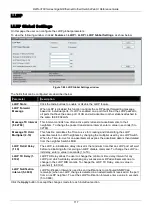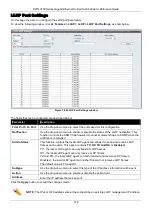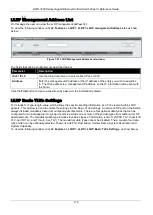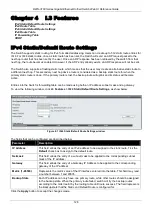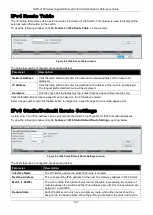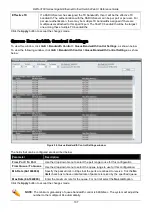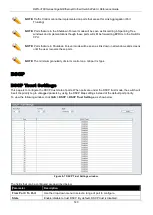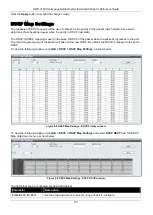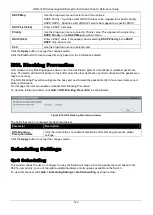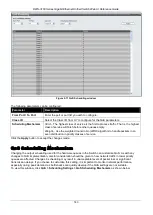
DWS-3160 Series Gigabit Ethernet Unified Switch Web UI Reference Guide
128
backup routes according to the order learnt by the routing table until route success.
This field represents the backup state for the IPv6 configured. This field may be
Primary or Backup.
Click the
Apply
button to accept the changes made.
Click the
Delete All
button to remove all the entries listed.
IP Forwarding Table
The IP forwarding table stores all the direct connected IP information. On this page the user can view all the direct
connected IP information.
To view the following window, click
L3 Features > IP Forwarding Table
, as show below:
Figure 8-4 IP Forwarding Table
The fields that can be configured are described below:
Parameter
Description
IP Address
Click the radio button and enter the IP address.
Interface Name
Click the radio button and enter the interface name.
Port
Click the radio button and enter the port.
Click the
Find
button to locate a specific entry based on the information entered.
Enter a page number and click the
Go
button to navigate to a specific page when multiple pages exist.
VRRP
Virtual Routing Redundancy Protocol (VRRP) is a function that dynamically assigns responsibility for a virtual router
to one of the VRRP routers on a LAN. The VRRP router that controls the IP address associated with a virtual router
is called the Master. The Master forwards packets sent to this IP address. This allows any Virtual Router IP
address on the LAN to be used as the default first hop router by end hosts. Utilizing VRRP, the administrator can
achieve a higher available default path cost without configuring every end host for dynamic routing or routing
discovery protocols.
Statically configured default routes on the LAN are prone to a single point of failure. VRRP is designed to eliminate
these failures by setting an election protocol that will assign a responsibility for a virtual router to one of the VRRP
routers on the LAN. When a virtual router fails, the election protocol selects a virtual router with the highest priority
to be the Master router on the LAN. This retains the link and the connection is kept alive, regardless of the point of
failure.
To configure VRRP for virtual routers on the Switch, an IP interface must be present on the system and it must be a
part of a VLAN. VRRP IP interfaces may be assigned to every VLAN, and therefore IP interface, on the Switch.
VRRP routers within the same VRRP group must be consistent in configuration settings for this protocol to function
optimally.




